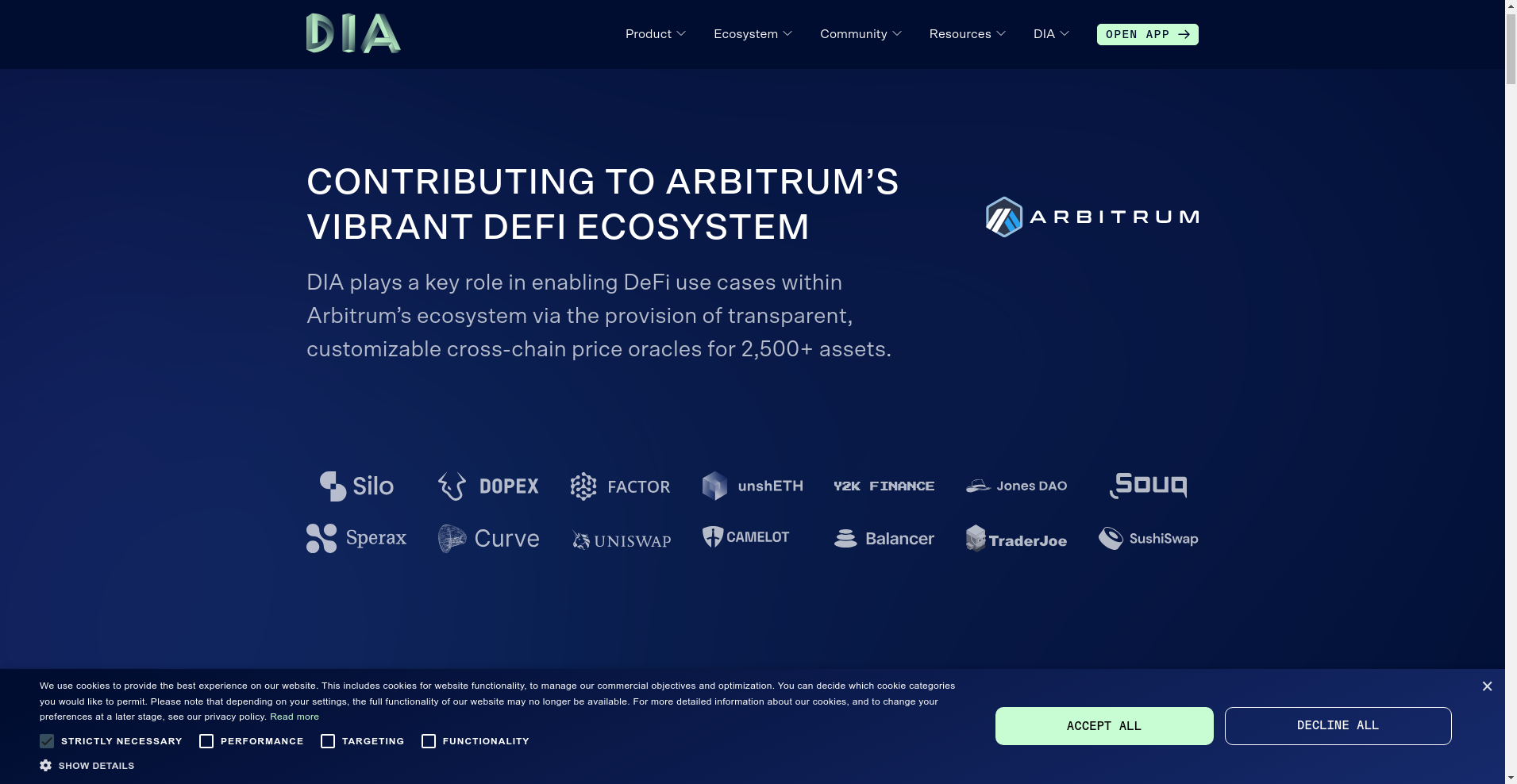DIA Review: Scam or Legit Crypto? Uncovering All The Red Flags

What Exactly Is DIA?
The DIA project markets itself as a decentralized oracle network designed to deliver transparent, verified data feeds for on-chain applications. Its core promise is to bridge real-world data — such as crypto prices, traditional financial assets, and randomness — directly onto blockchain ecosystems, enabling the development of complex DeFi and Web3 solutions. With claims of broad blockchain support and customizable data feeds, DIA appears to position itself as an infrastructure layer for the evolving decentralized finance space.
However, with ambitious claims comes the need for a thorough investigation. Is DIA genuinely a trustworthy project providing valuable services, or does it mask underlying risks or red flags that investors should be wary of? This review dives deep into available evidence, audits, tokenomics, and ecosystem activity to provide an evidence-based assessment of DIA’s legitimacy.
Who Is The Team Behind DIA?
The credibility of any crypto project heavily relies on its team and governance transparency. Unfortunately, DIA’s team remains largely anonymous, with most information coming from corporate and community reports rather than Doxxed founders. While the project claims to be community-driven and decentralized, the lack of publicly identifiable leadership raises questions about accountability and control.
- Team members’ identities are not publicly verified or listed on official sources.
- Most documentation emphasizes community governance rather than leadership transparency.
- The project has a clear roadmap and commits to grants and partnerships, but the founders’ backgrounds are obscure.
This opacity could suggest reliance on a distributed community for legitimacy, but it also raises red flags. Without proven and credible leadership, projects often struggle to deliver on promises or survive regulatory scrutiny. The roadmap points to ambitious technological milestones, but the lack of transparency about authority and decision-making diminishes trustworthiness.
DIA Security Audit: A Deep Dive into the Code
The only publicly available audit for DIA comes from Chainsulting, who examined the platform's smart contracts. The audit covers approximately 80% of the DIA platform's scope, indicating a moderate level of scrutiny, but not an exhaustive review.
- The audit found no critical vulnerabilities, which is positive; however, incidents or issues have been recorded for the platform historically, indicating some security concerns.
- The rating from Cer.live shows a score of 5.55 out of 10, which is middling at best, and "incidents" have been documented, albeit not detailed in this summary.
- Because only one audit exists, blind spots could remain, especially on the off-chain components or less scrutinized integrations.
While the smart contract code appears generally sound, the incomplete audit coverage and past incident reports suggest that potential vulnerabilities cannot be entirely ruled out. For investors, the presence of recorded incidents warrants caution, especially since the platform handles financial data relied upon by DeFi protocols.
Analyzing the DIA Token: Supply, Distribution, and Risks
According to available data, DIA's native governance token has a total supply of approximately 168.8 million tokens. The tokenomics details are limited, but here’s what is publicly known:
- Total Supply: ~169 million tokens, with distribution details largely undisclosed.
- Utility: Used for governance, staking, and potentially incentivizing data providers.
- Market Cap & Price: As of the latest updates, the market cap hovers around $58 million, with a token price near $0.49.
- Incentive Risks: The relatively high inflation and unspecified token distribution could lead to dilution or dumping, especially if early miners or team-held tokens are not locked or subject to vesting periods.
The token’s utility mainly ties to governance, but with limited transparency on its distribution, there’s a risk of centralization or whale dominance. As with many crypto tokens, there’s a concern about pump-and-dump schemes, especially given the project's relatively middling market cap and ongoing token emissions.
Is DIA a Ghost Town? Checking for Real Activity
Based on available summaries and recent updates, DIA exhibits signs of ongoing development and community engagement. The project boasts over 200 dApps integrated with its data feeds and maintains active social media channels, including Telegram, Reddit, and Medium posts.
Recent milestones include launching mainnet staking, expanding its oracle bridges to additional blockchains like Base, Arbitrum, and zkSync, and forming strategic partnerships with entities such as IMF, Ripple, and Denario Swiss for real-world asset management. These initiatives suggest that DIA’s ecosystem isn’t merely marketing fluff—there is tangible activity and roadmap progression.
However, the pace of development is moderate, and some of the advertised features—such as real-time data feeds for RWAs—are still in early phases or limited testing. The key question remains whether these efforts are sustainable and whether their claimed adoption figures reflect genuine user activity or inflated numbers.
The Fine Print: What DIA’s Legal Documents Are Hiding
Publicly accessible legal documentation on DIA is sparse, which is common in open-source projects. The lack of comprehensive terms of service, privacy policies, or legal disclaimers introduces potential risks:
- Potential ambiguity around data liability and dispute resolution exists, meaning users or integrators may bear significant risk if the data proves inaccurate or faulty.
- Few protections are offered for investors or dApp developers in case of platform failures or security breaches.
- The absence of a clear governance structure or legal entity raises questions about accountability or recourse in cases of malfeasance or damage.
This opacity could be a red flag, indicating that the project’s legal safeguards are minimal or undeveloped, exposing users to unforeseen liabilities.
Final Verdict: Should You Risk Investing in DIA?
This investigation uncovers a picture of a technically promising but fundamentally opaque project. While DIA has some operational activity, strategic partnerships, and a functional ecosystem, critical gaps remain in transparency, security attention, and governance clarity.
For investors or users considering DIA, here are the key points to weigh:
-
Positive Points
- Continued ecosystem expansion with new blockchain integrations
- Security audit completed with no critical vulnerabilities found
- Active development milestones and strategic partnerships
- Utilizes advanced data sourcing methodologies and multisource aggregation
-
Major Red Flags
- Largely anonymous team and lacking transparent governance
- Incomplete security audits, with known incidents not fully disclosed
- Limited legal documentation and unclear liability protections
- Tokenomics transparency issues—unclear distribution and potential inflation risks
Ultimately, DIA exhibits many qualities common to emerging oracle projects—technical innovation, active ecosystem, but also significant transparency and governance concerns. Investors should proceed cautiously, avoid overexposure, and keep an eye on further audits and community developments before considering DIA as a trustworthy infrastructure component.

James Carter
Chief On-Chain Analyst
On-chain analyst with a background in financial fraud detection. I use data science to dissect blockchains, find the truth, and expose scams. My motto: code doesn't lie.
Similar Projects
-
BabyPepe
BabyPepe ($BAPE) Review: An Impartial Analysis of Risks & Security
-
Felysyum
Felysyum Review: Scam or Legit Crypto? Find Out Now
-
BinkeGame
BinkeGame ($BINK) Review: An In-Depth Analysis of Its Disappearance
-
Akropolis
Akropolis Review: Scam or Legit Crypto? Scam Check & Legitimacy Analysis
-
Virtual Gamer (VGamer.io)
Crypto Project Review: Is VGamer.io a Legit Gaming & Blockchain Platform or a Scam?